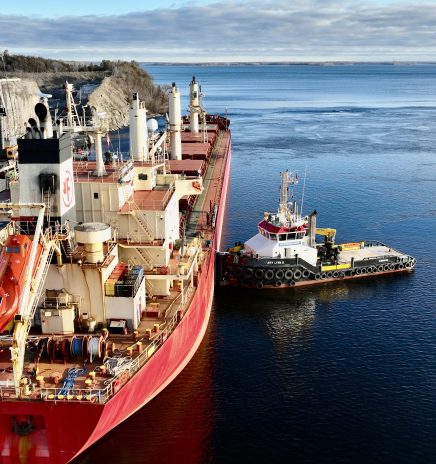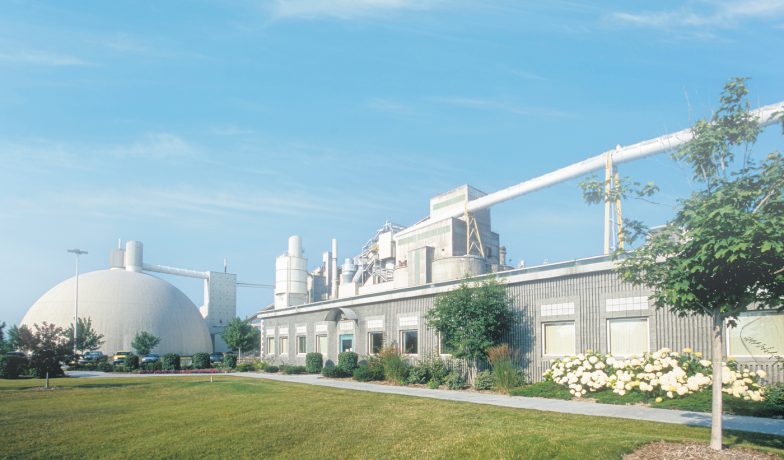Cement Market Transformation
LafargeHolcim Leads Change to Low-Carbon Product
Producing OneCem Portland limestone cement creates an immediate 10% reduction in greenhouse gas emissions. The engineered blend has been tested and proven an effective alternative to traditional Portland cement. It is manufactured with 10% finely ground limestone, which results in an equivalent in lower emissions.
With the availability of the needed limestone at onsite quarries, LafargeHolcim has transitioned plants in Alpena, Mich., and Bloomsdale, Mo., to making the new mix. And lakers are the primary transporters taking cement for the Lake Huron quarry and plant to customers throughout the Great Lakes states.
LafargeHolcim, with a Chicago, Ill., headquarters, considers OneCem a high-performance blend, able to be used in virtually any cement-based application, from residential construction to large-scale infrastructure projects. While the transition to the new blend does not directly impact the number of employees working the plants, it is expected to keep the Lafarge Alpena cement plant sustainable into the future. That, in turn, helps protect those jobs in northeast Michigan.
“Engineers, architects and developers are increasingly focused on integrating sustainability into building projects,” says Jeffrey Scott, plant manager. “It’s exciting that LafargeHolcim’s Alpena Cement Plant is in a position to answer this need. The building sector is still in the early stages of embracing ways in which to lower embodied carbon in building projects throughout the United States. OneCem can make an immediate impact in helping customers achieve their sustainable construction goals.”
The two plants producing the OneCem were recently transitioned after LafargeHolcim tested the product and transitioned its cement plant in Midlothian, Texas, in 2021.
The Lafarge Alpena plant in Michigan – one of the longest-operating cement-production facilities in North America – has the capacity to produce 2.4 metric million tons of cement annually for markets throughout the Great Lakes, the U.S. Upper Midwest and Ontario, Canada. The Holcim Ste. Genevieve plant in Missouri – the largest cement-producing facility in North America – operates the largest single-kiln line in the Americas with a capacity to produce 4.5 million metric tons of cement annually for markets throughout the Mississippi River Basin.
“LafargeHolcim is fully engaged in making carbon reduction an urgent priority and 100% dedicated to leading the market transformation needed for climate stability,” says Michael Nixon, vice president, manufacturing north at LafargeHolcim US Cement. “To achieve net-zero commitments by midcentury, we must start now in accelerating the adoption of low-carbon building solutions to mitigate the impacts of climate change.”
By converting operations to the low-carbon OneCem product, the Alpena and Ste. Genevieve plants will collectively reduce CO2 emissions by about 300,000 metric tons each year, which is equivalent to taking more than 70,000 cars off the nation’s roadways for a full year.
In 2021, LafargeHolcim sold more than 2 million tons of OneCem, resulting in a CO2 reduction of 100,000 metric tons. With production expanding, total sales will increase and, with them, the need for waterborne transportation through the Great Lakes. According to LafargeHolcim, three vessels move the majority of its cement from Alpena to terminals all over the Great Lakes. Railcars and bulk pneumatic tracks move the rest.
“Our use of lake vessels is the most efficient manner to move OneCem with the lowest carbon footprint of all transportation modes,” Scott says.
“As demands on the industry to reduce its carbon footprint intensify, we find ourselves with an unparalleled opportunity to build a more sustainable future,” says Patrick Cleary, senior vice president of sales, LafargeHolcim US Cement. “The materials used in building need to have the lowest embodied carbon possible without sacrificing performance and this is where our low-carbon OneCem can make an immediate impact in helping customers achieve their sustainable construction goals.”

Unlocking the Seaway’s Potential
Stakeholders have long said that the Great Lakes-St. Lawrence Seaway has the potential to increase service and contribute even more to North American trade and the international maritime industry. From efforts to expand container service to... Read More

Winding Down
As the Great Lakes-St. Lawrence Seaway System approaches its seasonal closure, the rhythm of maritime commerce slows. The Montreal–Lake Ontario section will cease transits after December 24, with all ships required to clear... Read More

